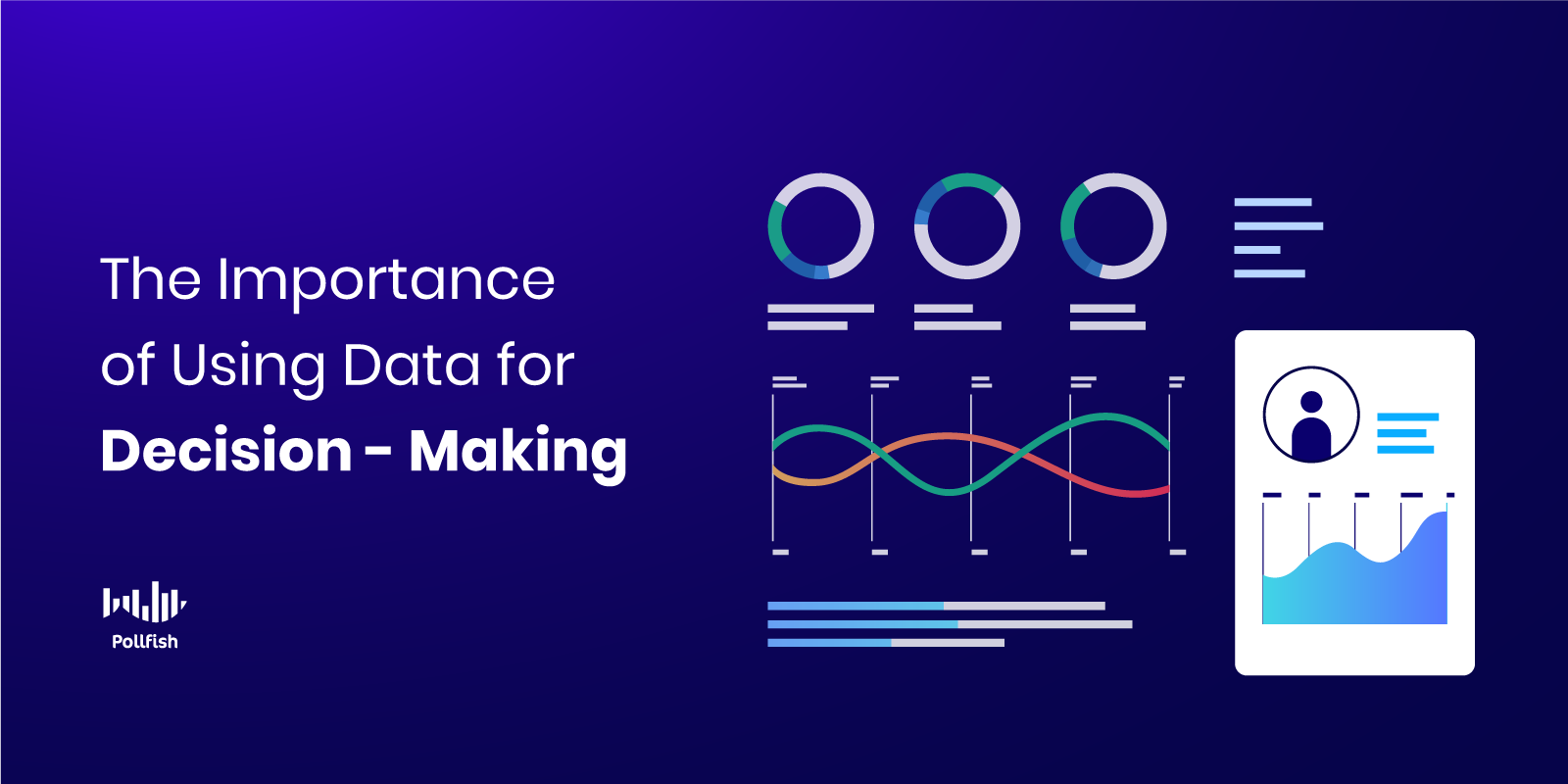How to Use Data for Decision Making

In the digital climate of the present, using data for decision-making is ever-important for businesses to thrive and remain competitive.
While the vast majority of businesses claim to be data-driven, only a small fraction of businesses actually implement data into their corporate strategy. In a recent report, 99% of businesses reported investing in data and AI, but only 30% have a data strategy for their business.
As such, even the businesses that invest in data are not using it to its full potential — if at all. Without updated data, businesses cannot stay abreast of their target market, competitors and industry at large.
This article explains how to use data for decision-making in the market research space, so that businesses can fully grasp the insights from the vast array of market research techniques.
The Value of Data in Market Research
Market research is a particularly data-driven field, as not only do consumer preferences change rapidly, but so do the consumers themselves.
The latter occurs as a target market does not remain stagnant; new segments emerge, while others may change in terms of behaviors, demographics or needs.
Thus, market researchers must always keep tabs on their target market and overall industry, as this kind of information is invaluable. Researchers should not leave any data unused, but thoroughly analyze it and incorporate all of their data for decision making.
There is virtually no other aspect in the business realm as valuable as data, especially the kind that is delivered in a timely manner with up-to-date information. When you gather the correct amount of data from the most relevant people, you are then equipped with the necessary insights to take any action or inaction.
Whether it’s changing your marketing messaging, keeping up with your brand tracking, gaining customer loyalty or even increasing your CLV (customer lifetime value), having access to the right kind of data can help you improve your business in leaps and bounds.
After all, in order to make your target market aware of your business, delight customers and retain them, you need to understand them, their needs and expectations to the fullest extent. WIthout consumer data, you are essentially navigating in the dark.
This is largely because, as aforementioned, customer preferences and the makeup of a target market is highly subject to change.
As such, aside from investing in data, businesses ought to put it to use, to strategize with their data for decision making. When businesses leave their data dormant, then they are not data-driven.
Understanding Data-Driven Decision Making
The concept of being data-driven has driven a rise in claims across businesses, yet many do not commit to a data-driven culture.
When it comes to data implementation, one study has found that 94% of businesses say that they are beyond the planning stage of implementing data into their business, yet only 38% believe it is well-connected to the corporate strategy.
In another 2021 study, 62.0% of firms reported investing over $50 million in data and artificial intelligence, yet only 30% have built a well-defined data strategy.
Evidently, there is a disconnect between investments and usage. This can occur due to a number of reasons, including lack of time allocation to strategy or in-house resources that can fully adopt and adapt to the data.
First off, before attempting to foster a data-driven company, businesses ought to understand the precise meaning behind the term “data-driven.”
This concept alludes to a process of using data for decision making, in which researchers collect data, detect patterns from the data, put together an analysis and use that analysis to make inferences about subjects — particularly your target market — that would be used for taking actions.
Data-driven decision-making (or DDDM) has thus sprung from this concept. DDDM refers to the process of making data-informed decisions rather than anecdotes, past observations or intuitions.
Instead, the data a business derives from market research is used as the primary guiding source for decisions, changes and applications.
The Benefits of Applying Data for Decision-Making
There are various benefits of being data-driven, as outlined in a previous section, especially in relation to market research. There are plenty of more concrete ways in which data benefits a business, in ways that reach far beyond decision-making alone.
 The following lists the various other benefits that businesses can reap when they take up the DDDM position:
The following lists the various other benefits that businesses can reap when they take up the DDDM position:
- Data provides crucial insights that can enhance the overall performance of a business.
- They can do so by monitoring a variety of metrics that provide actionable insights.
- The DDDM position allows businesses to make incremental changes. This forges continuous improvements on various fronts, depending on the kind of data it uses.
- It is entirely fact-based, as such, decision-making is not entirely reliant on the knowledge or skills of any team members, but rather the insights themselves.
- The facts derived from DDDM enable a greater capacity to implement changes and scale them.
- DDDM is ideal for improving staff work and engagement, as it allows for greater transparency and accountability.
- It helps businesses identify their risks and threats to tackle them sooner rather than later.
- Collecting data is necessary for record-keeping and compliance, allowing companies to be accountable when it comes to managing data.
- It allows companies to prioritize their tasks and goals and deem which are practical and which aren’t.
- Results can be measured via the data collected, which is also ideal for market research techniques, whether it comes from studying:
- Employee sentiment via an employee feedback survey
- Product opinions via the product satisfaction survey
- Customer experience (CX) via a customer experience survey
- Customer development
- Thoughts on an advertising campaign
- Brand tracking
- It allows companies to justify taking an action or change by assessing themselves and their customers, testing different methods and understanding what is most useful for their target market.
How to Use Data for Decision Making
Although data is of the essence when it comes to making results-oriented decisions, it can be overwhelming to gather and parse. When it comes to the former, a business may not know all the applicable methods for gathering data, including how to reach out to its target market to aggregate the data.
In regards to the latter, a business may experience difficulty when analyzing data, including the ways to organize it and visualize it and make the next steps.
The following explains how to use data for decision-making with the DDDM approach.
- Narrow down a goal or issue to prioritize for your data.
- List the various problems your business is facing.
- List the various curiosities your business has in regards to its campaigns or target market.
- Find one or more issues that require the most attention.
- Once you’ve narrowed down an issue, decide on what you need to improve, or which aspects are in want of more information.
- Find a source of data best-suited for your DDM priorities from the first two steps
- Create a preliminary budget. Then determine which tool can best fort the budget and your data needs.
- Choose from the following:
- Website analytics
- Market research
- Secondary research: various industry publications, statistics sites and other sources
- Primary research: survey tools, online panels
- CRM software
- Business intelligence platforms
- Social listening tools
- Run a campaign around your source of data.
- After you’ve gathered your first round of data, organize it in a digestible manner.
- This will largely depend on the source you use.
- This may involve working with graphs, charts spreadsheets and more.
- Analyze your data.

Consider the following:
- Did you receive answers to your concerns?
- Do you need more information? If so, run another similar data extraction campaign.
- Divide your findings in the following ways:
- Descriptive Information: Includes all the facts from the data you collected.
- Inferential Information: Includes the facts, and their interpretation within the context of a particular project.
- Predictive Information: An inference based upon facts and advice for further action based on your reasoning.
- Draw conclusions.
- What new information have you gathered from your findings?
- Create a document with the most critical information you reap and share it with your team.
- Can you apply the findings to new strategies or do you need further insights?
- Has your data analysis confirmed or disproved your hypotheses?
- What new information have you gathered from your findings?
- Strategize and plan based on your data.
- Meet with other team members to discuss plans on improving strategies or creating completely new ones based on the data you derived.
- Measure and monitor your efforts — repeat if need be.
- Data-driven decision-making (DDDM) is not a one-off method.
- Rather, it should be used continuously to make accurate assessments about your customers, business campaigns and other crucial aspects pertaining to your business.
- Consider the following: did your DDDM decision lead to a positive impact on your business?
- If yes, that’s wonderful.
- If no, not to worry. It is better to be equipped with facts for making decisions and in the vent that you didn’t drive as much positive change, you can better decide future goals and strategies.
Creating Constant Improvements
Many companies, especially those in the tech field, seek to be data-driven. While most are open to implementing data for decision-making, a fractional portion actually follows through, as aforesaid early in the article.
Companies that have lagged on fully incorporating data into their decisions are not as well-suited to make innovations, test hypotheses and fully understand their customers’ behaviors and needs. On the contrary, companies that do use data for making decisions avoid the pitfalls of strategizing on intuition alone.
The key is to prioritize your goal and use the correct data-culling tool. Given the sweeping area of studies that market research encompasses, it is important to rely on primary research in order to stay abreast of the latest needs of your target market.
As such, a market research data tool, such as an online survey platform is thus paramount to use. Such a tool makes it easy to create surveys, target the desired (and correct) sample, deploy the surveys and have them completed in a timely manner.
Businesses ought to choose wisely when it comes to selecting an online survey platform, as the proper kind will drive well-informed decision-making without any hassle.
Pollfish Marketing Team
Ready to Try Pollfish?
Create your survey with AI, target high-quality respondents starting at $0.95 per complete, and start getting results in just minutes in real-time. From running a simple product concept survey to managing a constant stream of trackers for dozens of clients in dozens of countries, we’ve got you.

